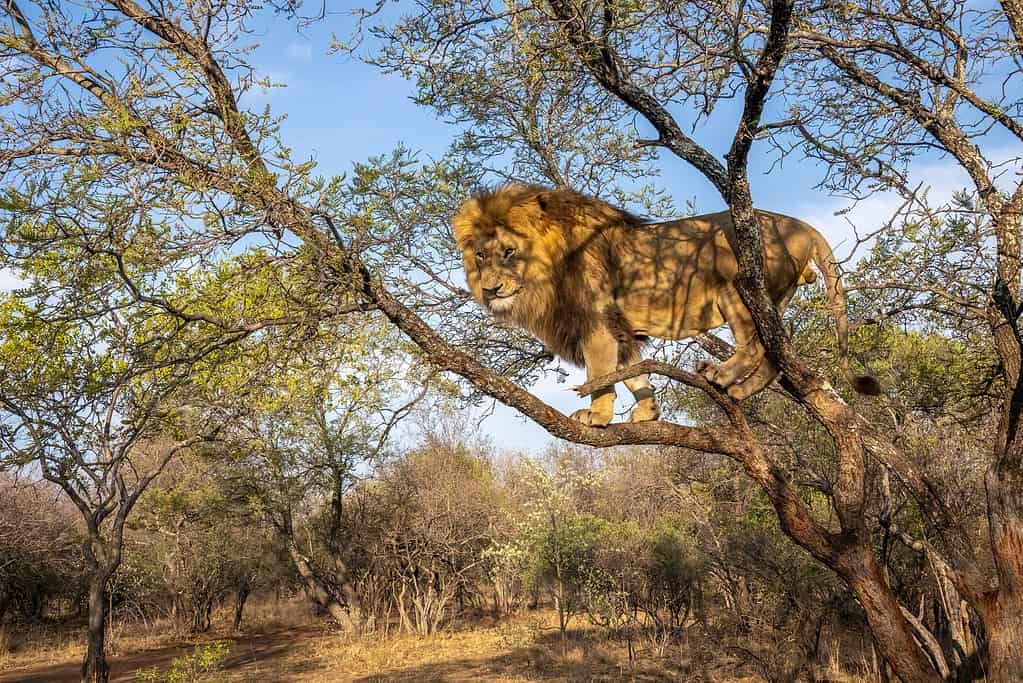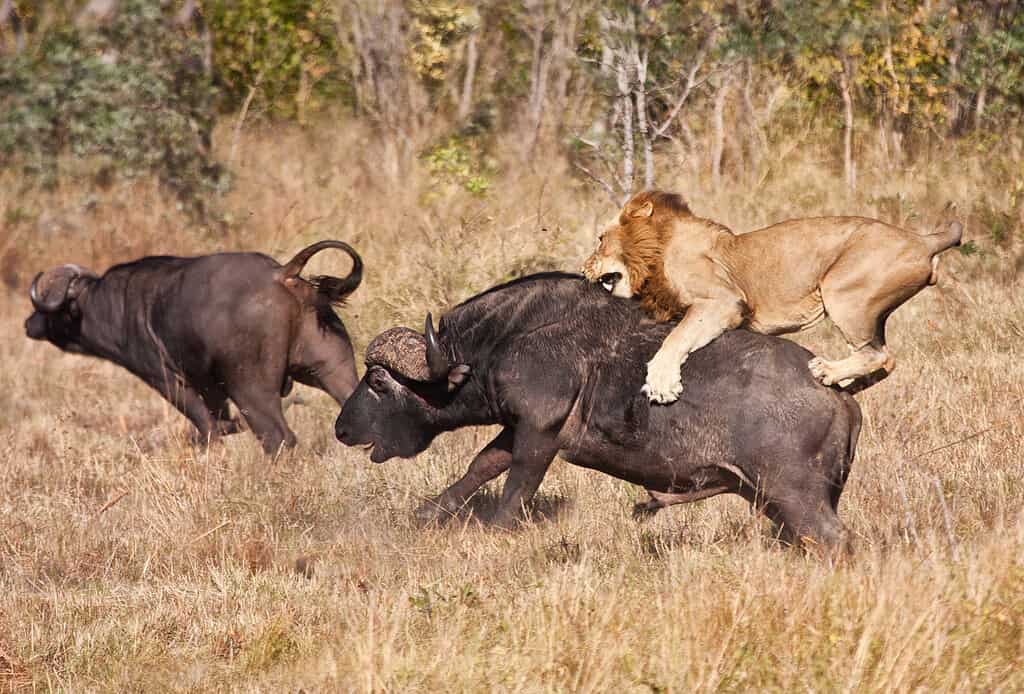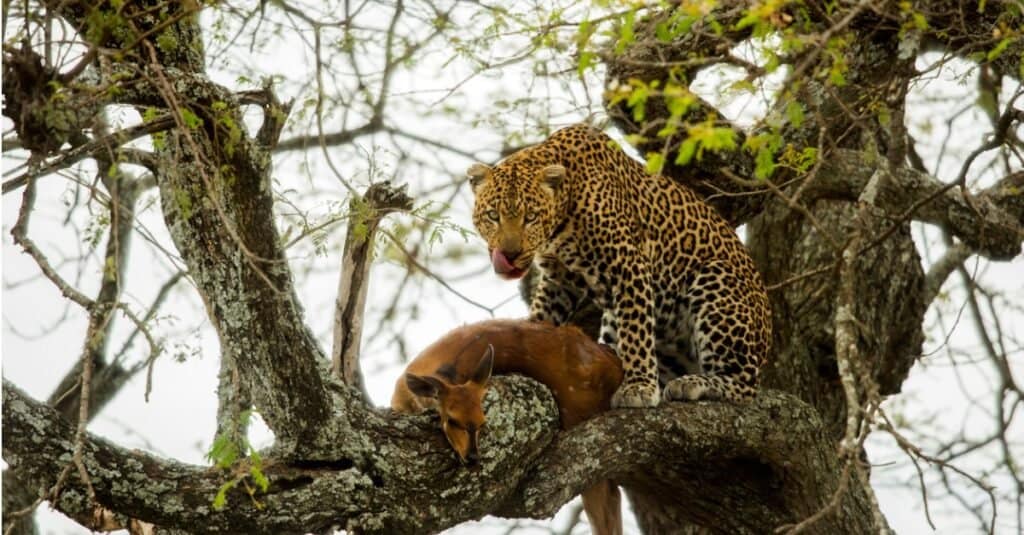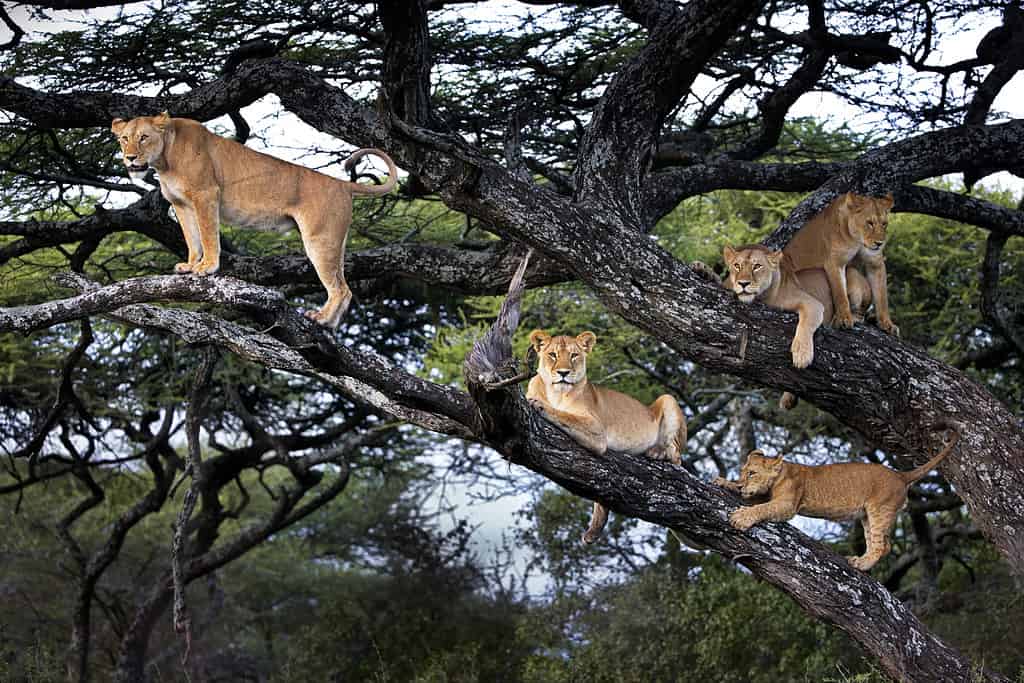The lion (Panthera leo) is commonly known as the “king of the jungle,” but that raises a question: can this king climb the trees in its kingdom?
Yes, lions can climb trees.
Lions in certain locations are often spotted in trees. The lions of Queen Elizabeth National Park in Uganda climb trees regularly. The same goes for the lions in Lake Manyara National Park in Tanzania. Kruger National Park in South Africa also features tree-climbing lions.
The lions in these areas are the exception rather than the rule, though. Elsewhere, a lion in a tree is a relatively rare sight. While lions can indeed climb trees, their physical makeup doesn’t make climbing all that easy. They also don’t need to climb trees for the same reasons that other cats do.

This large male lion in South
Africa
demonstrates that even the big boys can climb trees when they want to.
©Evelyn D. Harrison/Shutterstock.com
The Lion’s Physical Build
Lions are not designed for climbing like other big cats, such as cougars, jaguars, and leopards. Those cats are built for climbing, while the lion is built for power.
To use an illustration from the sports world, consider the different positions on a football team. Skill positions, such as wide receivers, train with agility drills. Non-skill positions, such as linemen, train with heavy blocking sleds. One position focuses more on nimbleness, while the other focuses more on brute strength. While it is obviously not a perfect analogy, cats such as leopards are the wide receivers, while lions are the linemen on Team Feline.
Built for Strength
Lions are not as agile and nimble as other cats, but they are among the strongest of the big cats. The lion’s heavy muscular frame and very stiff back are designed to take down large prey animals, such as buffalo. An African buffalo can weigh up to 2,000 pounds, four to five times the weight of an adult lion. Lions need all the brute strength they can muster to bring down prey of this size. The tradeoff is these cats are less adept at climbing a tree.
Leopards, on the other hand, are hyper-flexible and are also significantly lighter than a lion. A female lion can weigh 300-400 pounds, while a male can weigh 400-570 pounds. A female leopard weighs less than 130 pounds, while a male tops out at 165 pounds. Leopards are up to three times lighter than lions and can shimmy up a tree with ease.
Lions have a lot more bulk to haul up a tree. While lions can scale a tree, it is more arduous and awkward. It can even be dangerous. A heavy male lion risks dislocating a leg as he descends from a tree.

Lions have the brute strength to take down prey that outweighs them multiple times over, such as buffalo.
©iStock.com/AOosthuizen
Little Need to Climb Trees
Prodigious climbing cats such as leopards and jaguars need the security that trees provide. Food caching is essential for these felines. By hoisting a kill into a tree, the risk of kleptoparasitism (having their kill stolen) goes down significantly.
Leopards will often carry a kill into a tree so it can’t be stolen by hyenas. A cackle of hyenas can chase a solitary leopard off of a kill, but those hyenas can’t follow a leopard into the treetops.
This is a primary reason why leopards may sometimes pass up a larger prey animal for something smaller. The larger animal would provide more nourishment for the leopard, but only if the kill isn’t stolen. A more intermediate-sized animal is easier for the leopard to hoist into a tree. By caching its food in the tree, the cat has the opportunity to feed longer and consume more calories overall.
Lions, on the other hand, are at a far lower risk of kleptoparasitism. In fact, lions are often the thieves rather than the victims of theft. Hyenas are thought of as the bandits of the sub-Sahara, but lions are actually more prone to thievery than hyenas. With their size and strength, lions can steal a kill from other predators with relative ease.
Lions also don’t need to climb trees to escape from predators. While lion cubs are at risk of predation, mature lions are Africa’s apex predators. They also live in prides, where their numbers add yet another layer of protection. Many tree-climbing animals use treetops to hide or escape, but not lions.

Leopards often hoist prey into trees to protect it from kleptoparasitism.
©iStock.com/GlobalP
Climbing Lions
Why do lions in the national parks mentioned at the beginning climb trees more regularly than others? While there is no definitive answer, there are a few possible reasons.
Protection
As noted above, many animals that climb trees do so at least partially for protection. The lions in certain areas may do so, as well. It is not for protection against predators, though. As was also noted above, mature lions have few worries when it comes to natural predators. However, the lions in some of Africa’s national parks live in smaller prides. They also share the parks with large herds of elephants and buffaloes. A stampede could injure or crush a lion, but that lion can’t be trampled in a tree.

While mature lions have little need to worry about predators, an African
Water Buffalo
stampede can pose a threat.
©iStock.com/andyschar
Hunting
Climbing trees provide lions with a better vantage point as they scan the landscape for prey. It is possible these lions climb trees to help them scope out their next potential meal.
Insects
Insects such as biting flies can swarm along the ground. When biting insects are especially prevalent, lions may climb trees in an attempt to escape these pests.
Comfort
When the sun is high in the sky, temperatures can soar well over 100°F in sub-Saharan Africa. The shade offered in a tree’s canopy is a welcome respite from the unrelenting sun. All lions seek shade to rest during the heat of the day, but the lions in these national parks can regularly be seen snoozing the day away in the treetops.
Thievery
While it is exceedingly rare, there have been documented cases of lions climbing trees to pilfer a leopard’s kill. A research team caught this incredible event on video.
Learned Behavior
The lions in these national parks are no different than the lions in other parts of Africa. They have no special adaptations that allow them to be better climbers than other lions. So how is it that the lions in these areas climb trees so much more often than other lions?
It seems clear that it is a learned behavior. It could be a combination of any or all of the reasons listed above, but the lions in these regions have learned the benefits of climbing trees. Lion cubs are eager to mimic the behaviors of their elders, so once tree-climbing became the norm for these prides, it was a behavior that was easily passed to the next generation. The behavior has become a “family tradition” of sorts among these lions.

This lion pride in Tanzania has learned the benefits of tree climbing and is passing the knowledge down to the next generation.
©iStock.com/Wirestock
What Kinds of Trees Do Lions Climb?
Lions are not built to scale a vertical tree trunk like smaller, more agile cats. These big cats often look for trees with branches close to the ground. They use those low branches to hoist their bulky bodies into the tree.
Popular climbing trees for lions include African sycamores and umbrella thorn acacia trees.
The photo featured at the top of this post is © iStock.com/Jennifer Watson
Thank you for reading! Have some feedback for us? Contact the AZ Animals editorial team.







